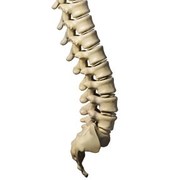 iStockphoto/Thinkstock
iStockphoto/Thinkstock
At the bottom of the vertebral column is the coccyx, also called the tailbone. Different injuries and disorders can affect the coccyx, resulting in discomfort for the patient.
Examples of the disorders of the coccyx are tailbone trauma, coccydynia and chordoma.
Tailbone Trauma
When someone has tailbone trauma, she has sustained an injury to the coccyx. Having a fracture of the coccyx is not common, according to MedlinePlus.
Instead, individuals with tailbone trauma will have a pulling of the ligaments around the tailbone or bruising of the actual bone. Falling backward onto the coccyx can cause tailbone trauma.
This may occur if an individual slips on ice. Symptoms of tailbone trauma include pain when putting pressure on the coccyx or bruises on the lower part of the individual’s spine.
First aid can be done with tailbone trauma, but only if a spinal cord injury is not suspected. If you suspect that an individual with tailbone trauma has sustained a spinal cord injury, do not move her and seek immediate medical attention.
In cases where there is no spinal cord injury, first aid options include taking stool softeners to avoid constipation and over-the-counter pain medication, such as acetaminophen, for the pain. Non-medication options include cushions or an inflatable rubber ring, which can help reduce pressure put on the coccyx.
Coccydynia
When individuals have pain around the coccyx, it is called coccydynia. One cause of coccydynia is tailbone trauma, though most cases of tailbone pain are unknown, according to the Cleveland Clinic.
Other causes include tumors, infections and excessive mobility of the coccyx. Individuals with coccydynia have pain when they put pressure on the coccyx. For example, they may experience pain when sitting in a hard chair, but the pain is alleviated when they are walking or standing.
Other possible symptoms of coccydynia include pain during sex or bowel movements, a deep ache around the coccyx, and pain, which can range from immediate to severe, when transitioning from sitting to standing.
To cope with coccydynia, individuals may use nonsteroidal anti-inflammatory drugs, such as ibuprofen, and therapeutic sitting cushions. The medication can relieve the pain, while the therapeutic sitting cushion helps take pressure off of the coccyx.
For some individuals, their treatment may also include physical therapy, coccygeal manipulation or a special surgery called coccygectomy. Physical therapy works on strengthening the ligaments and muscles around the coccyx.
That form of treatment may also include massage, ultrasound and heat. If an individual undergoes coccygeal manipulation, her health care professional will move her coccyx into its proper position, which the Cleveland Clinic noted will help reduce the pain.
Coccygectomy, removal of the coccyx, is done in severe cases of coccydynia in which other treatments do not manage the pain. However, like other types of surgeries, coccygectomy does carry risks patients should keep in mind, such as the risk for infection and the possibility that the surgery will not relieve the pain.
Chordoma
A rare disorder of the coccyx is a chordoma, which is a rare type of malignant bone tumor. The American Academy of Orthopaedic Surgeons stated that chordomas account for about 1 percent of malignant bone tumors, with 40 percent of these tumors occurring in the coccyx, as well as the base of the skull and the sacrum, or base of the spinal cord.
The cause of this type of tumor is unknown. Chordoma usually occurs in adults, with patients ranging between the ages of 40 and 70. However, in some cases, chordomas occur in children.
This type of bone tumor can spread to other organs in the patients’ bodies, with chordomas spreading to the lungs in 20 to 30 percent of cases, according to the American Academy of Orthopaedic Surgeons.
Treating a chordoma can be difficult, due to its location in the body. The preferred treatment is surgery, as chemotherapy is not effective and using only radiation has not been fully effective, according to the American Academy of Orthopaedic Surgeons.
Some patients may get a combination of surgery and radiation. If surgery cannot fully remove the tumor, patients may have radiation afterwards.
References
MedlinePlus Medical Encyclopedia. Tailbone Trauma. Web. 7 May 2012
http://www.nlm.nih.gov/medlineplus/ency/article/000008.htm
Cleveland Clinic. Coccydynia (Tailbone Pain). Web. 7 May 2012
http://my.clevelandclinic.org/disorders/coccydynia/hic_coccydynia_tailbone_pain.aspx
American Academy of Orthopaedic Surgeons. Chordoma. Web. 7 May 2012
http://orthoinfo.aaos.org/topic.cfm?topic=A00084
Reviewed May 7, 2012
by Michele Blacksberg RN
Edited by Jody Smith






Add a CommentComments
There are no comments yet. Be the first one and get the conversation started!